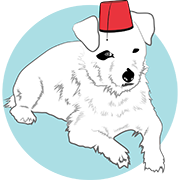Now that I’ve scared you with all the horrible things that can go wrong with professional grooming, it’s only fair that I offer some advice about how to avoid these, er, hairy situations.
To wit:
Get a reference
Yes, this is a no brainer, but sometimes it’s easy to be fooled by an appealing ad or charming sign on a pet boutique. Ask your vet, neighbors, friends and family members to recommend places they’ve had a track record with — not those they’ve just tried once.
Tour the facilities
Drop in unannounced and say you’re looking for a new groomer and want to look around. If you’re not allowed into the area where the grooming is done, leave.
Things to look for while you’re checking the place out include:
- Cleanliness. Not only of the cages but also of the entire room. You don’t want your dog rolling around in other dogs’ dirty, discarded hair.
- Safety. As alert commenter Mary Haight of DancingDogBlog noted in my last post, some groomers leave scissors and other sharp instruments on the table near the dogs — an open invitation to injury.
- Spaciousness. Your dog should have plenty of room to move around in a cage, maybe read a few magazines, while waiting his turn to be groomed.
- Kindness. Another no-brainer, but sometimes brusqueness is mistaken for professionalism. The staff should act as though they actually like dogs (yours in particular).
- Up-to-date equipment. Aside, of course, from cage dryers. Check also to see that the hand dryers don’t use heat. The latest models, geared specifically towards pet grooming, work with cool air alone.
Talk to the staff
Don’t only chat with the owner, but also with the groomer who’s likely to be working on your dog. Since a license may not be required, you can’t ask a staff member to produce one, but you can ask her about the type and length of her experience and what inspired her to choose the profession (“I just got out of the slammer and this was the only job I could get without references” is not among the correct answers). You can also ask about her grooming philosophy; she doesn’t have to quote Heidegger or Spinoza, only tell you how she feels about what works best for her canine charges.
In the end, trust your gut –- and your dog. If you’re feeling uneasy and your usually calm, outgoing pup starts shaking and whimpering, head for the door.
Go mobile
Consider having a groomer come to you; this is an especially good option for fearful and elderly dogs (and owners) and it eliminates such potential grooming hazards as waiting, cage drying, and unobserved meanness. Mobile grooming vans are common in many cities, but they generally require a water hookup, which means they can’t service urban high-rises or even many suburban apartment complexes. If you don’t mind a temporary mess, most groomers who are willing to make house calls would also willing to use your bathroom as a workspace, and even to clean up afterwards.
Take responsibility
Groomers have to rely on the information you give them about your dog. You have a responsibility to be honest with them –- and with yourself. Of course you have the best dog in the world, but face it: others might (irrationally) find him intimidating.
When a groomer discusses possible scenarios with you –- how your dog responds to his feet being touched, for example — tell the truth. Some dogs are generally polite but go ballistic when confronted by strangers with shiny instruments. A good groomer will tell you whether or not she is equipped to handle the type of behavior you describe –- or ask you if it’s okay to use tranquilizers. These should be a last recourse, and you should only use a type to which you know your pup is not sensitive. Still, if your dog is in danger of being condemned as a public health hazard, sedation might be in everyone’s best interest.

Your first tip–getting a recommendation makes the most sense, and touring the facility and talking to the groomer are essential. Trust your gut so you know your dog is in good hands.
This is a very helpful post.
Thanks, Michele. It’s so easy to bypass all of these things, thinking that grooming is no big deal…
I had no idea that there was sooo much to this. And there seems to be two moving parts – the temperment of the groomer and the temperment of the dog. So even if you got a good recommendation from someone about a groomer who worked well with THEIR dog, the groomer might night do as well with YOUR dog.
Ha, who knew getting your dog’s hair trimmed was so complicated? Seriously, I think a good groomer will know how to handle most situations — as long as he or she is given all the relevant information about the dog’s behavior.
This is great stuff…most of us don’t stop to think of all these details until something bad happens and *then* we recall shortcomings and problem areas of a service. You are so right to tell people to trust their gut or the way their dog is behaving. If it seems weird or “off”, it is. Just leave and don’t look back. Too many people feel awkward about doing this; better to feel a little awkward than having something awful happen to your dog. And thanks for mention:)
Very informative indeed, the best tip is knowing the staff, most especially the groomer. A close friend had some experience with her dog develop some fear and anxiety just after her grooming, good thing they learn the news about this short temper groomer from other clients having the same problem on fear behavior of the dog.
You do wonder why some people want to work with animals, don’t you? Thanks for writing in, Hannah.